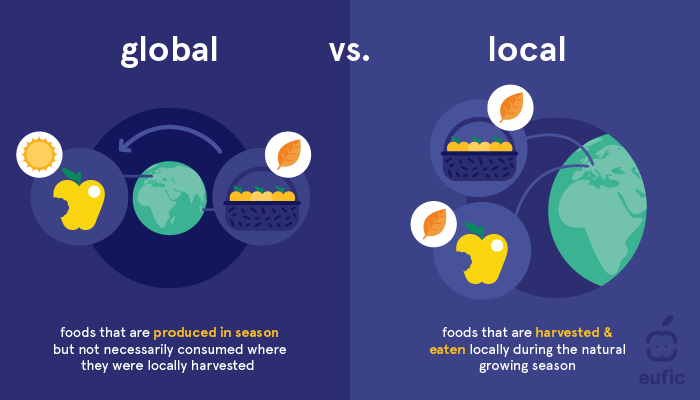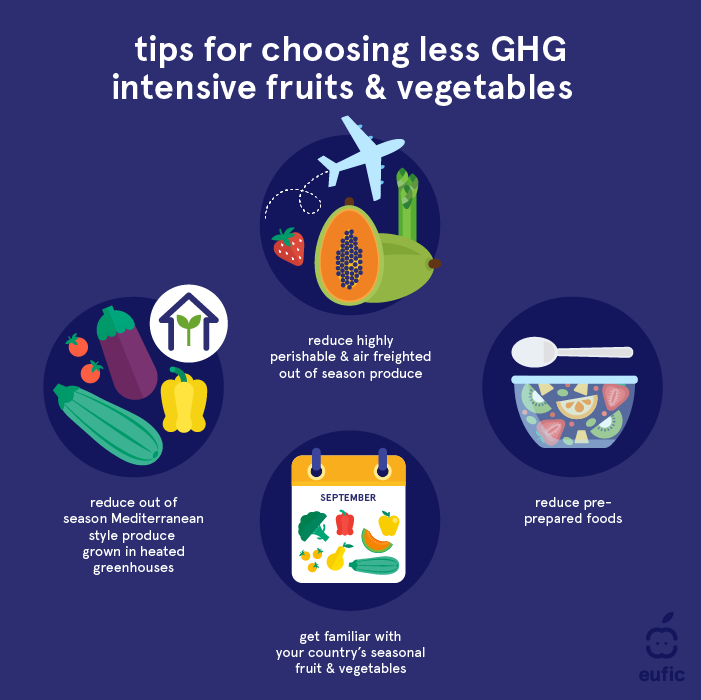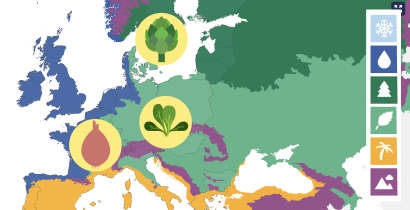Are seasonal fruit and vegetables better for the environment?
Last Updated : 09 September 2020The globalisation and mass distribution of fruit and vegetables worldwide allows us to enjoy a large variety of produce at any time of the year. Eating more seasonal fruit and vegetables has become an increasingly popular message to improve the sustainability of our diets. Yet, seasonal is hard to define and we need to explore it further, as well as the environmental impact of our fruit and vegetables.
Fruit and vegetables are important parts of a healthy and sustainable diet. They provide essential vitamins, minerals and dietary fibre, and tend to have a lower environmental impact than animal-based foods.1 Increasingly, we are hearing the advice to ‘eat seasonal’ to help reduce our environmental footprint, but how much does seasonality affect the environmental footprint of the fruit and vegetables we eat?
What does seasonal mean?
Each type of fruit and vegetable has its own set of specific conditions for ideal growth and quality. For this reason, fruit and vegetables are grown and harvested in different locations and in different seasons throughout the year. For example, oranges are climate-sensitive plants and grow better in places with hot dry summers such as Spain, Italy, and Greece.2,3
The term ‘seasonal’ is not well-defined and changes depending on the context it is used in. For some, ‘seasonal’ is synonymous with foods harvested ‘locally’, for others it is closely connected to cultural events and for a third group, it involves reconnecting with the origins of the foods and learning about the natural growing seasons. While these are worthy definitions and reasons for eating more ‘seasonally’, the differences show the lack of clarity around the term and how complicated defining ‘seasonal fruit and vegetables’ can be.4
For the purpose of this article, we will use the Department for Environment, Food and Rural Affairs (DEFRA) in the UK’s definitions of seasonal food, where the main aspects depend on when the foods were produced and where they were consumed (figure 1):4,5
- Global seasonality: based on where the food is produced. This refers to foods that are produced in season but not necessarily consumed where they were locally harvested. For example, apples grown and harvested during the growing season in New Zealand but eaten in Europe during the spring and summer seasons.
- Local seasonality: based on where the food is produced and then consumed. This refers to foods that are harvested and eaten locally during the natural growing season. For example, apples grown and harvested during summer and autumn, and eaten in October, in Europe.

Figure 1. The difference between global seasonality and local seasonality
What is the environmental impact of seasonal fruit and vegetables?
The foods we eat not only affect our health, but also the health of the environment. These environmental impacts are measured using a method known as life cycle assessments (LCAs). This technique helps us measure and understand the impact of foods on the environment throughout the stages of the supply chain; from growing, harvesting, storing, transporting, all the way to consumption (figure 2). Many studies concentrate on estimating the carbon footprint through greenhouse gas (GHG) emissions. However, it is important to remember that GHG emissions are only one side of a complicated story about environmental impact and the sustainability of food production. Other measurements include water footprint and pollution, pollution from fertilisers and land used: the totality of all these impacts is complicated to include in all studies.4,6 In this article we will only focus on GHG emissions.
By using LCAs, researchers have found that the global food system accounts for around 26% of the world’s greenhouse gas (GHG) emissions.1 However, there are big differences in how much GHGs different types of foods emit. In general, fruit and vegetables have lower GHG emissions compared to animal products such as beef and dairy, in fact as much as 10-50 times lower.1

Figure 2. The Food Supply Chain
What about seasonal fruit and vegetables? The environmental benefits of seasonal fruit and vegetables are often attributed to the shorter distances they travel. While the type of transportation might be significant for some fruit and vegetables, such as with air-freighted produce (e.g. berries, tropical fruit and green beans), the contribution of transportation to the carbon footprint is usually lower than the emissions coming from the methods of production.1 While climate-controlled greenhouses can mean less land used, less food wasted, lower pesticides and high yields, the energy needed to heat these buildings is significant. So much so, that global seasonality can be an environmentally-friendly choice as well. Let us look at some examples:
When tomatoes are grown locally but outside of their season in heated greenhouses, they have higher carbon footprints compared to those grown in season outside in Spain and then transported to, for example, the UK. The carbon footprint of tomatoes in season in Spain is lower because greenhouses require a lot of energy and by doing so, they emit GHG emissions. These emissions tend to be higher than those emitted by transportation from Spain to the UK.6
Local apples that are harvested in October in Europe but stored until August the following year and then consumed locally would have a higher carbon footprint than if the apples were locally and seasonally harvested in New Zealand, shipped and eaten in Europe outside of the European apple season. This is because as the storage time in refrigerators increases, the amount of energy needed increases as well, thereby emitting more GHG emissions.6
The overall picture that emerges from research, is that the fruit and vegetables with the lowest GHG emissions are those that are grown outside during their natural season without much use of additional energy and consumed in the same country or region. These have environmental benefits because they use less energy for artificial heating or lighting, for refrigeration and storage and avoid losses during storage, which generally helps to produce less GHG emissions, compared to fruit and vegetables that are grown under protection, are imported or stored.4,5
European Seasonal Fruit and Vegetable Interactive map
Check out examples of seasonal and local fruit and vegetables in countries around Europe.
Are seasonal fruit and vegetables more nutritious?
Well, the evidence suggests that the nutritional value of fruit and vegetables are highest immediately after harvesting and decline over time. Once fruit and vegetables are harvested, they are transported and placed in storage to reduce spoilage and to maintain their nutritional quality. While storage and transportation have been linked to decreases in some micronutrient levels, the losses are still minimal in terms of the overall health benefits when you compare them to not eating fruit and vegetables at all.4
Should we eat seasonal fruit and vegetables?
In short, yes! Buying local and seasonal fruit and vegetables may mean you get a larger variety of produce to choose from and in some situations, locally produced seasonal foods may be the best environmental option. However, choosing locally produced and in season fruit and vegetables is just one aspect of eating more sustainably. Increasing plant-based foods such as fruit and vegetables in the diet, reducing animal-based foods such as beef and dairy and minimising food waste are equally as important.
When it comes to a sustainable diet, it is more about what you eat, than where your food comes from.
While local and seasonal produce may have lower environmental impacts, global seasonality has helped not only expand global food markets but perhaps more importantly helped to provide a more varied and consistent supply of fruit and vegetables all year round, helping to increase the diversity of your diet and making sure you get a good balance of micronutrients throughout the year, especially for if you live in a country that has limited production seasons.4
Tips for choosing less greenhouse gas (GHG) intensive fruit and vegetables
It is not always clear where the fruit or vegetable you pick up in the market comes from. You might see a sign of the country where it was grown but whether it was grown in a greenhouse or transported by truck or train is almost impossible to tell. Here are some helpful tips on how you can choose less GHG intensive fruit and vegetables (figure 3)7:

Figure 3. Tips for choosing less GHG intensive fruits and vegetables
- Reduce highly perishable and air freighted out of season produce: fragile, highly perishable, and out of season soft fruit (berries, cherries) or exotic fruit (lychees, papayas, passion fruit) and out of season vegetables (asparagus, green beans, peas) are often transported by airplane because they spoil quicker. This greatly increases their GHG emissions.
- Reduce out of season Mediterranean style produce: these are often grown in heated greenhouses around Europe or under protection (sometimes heated) overseas, all of which requires additional energy input. Examples include tomatoes, courgettes, aubergines, peppers, salads, and cucumbers.
- Pre-prepared produce: this includes trimmed or chopped produce, like salad bags, bowls, fruit salads and pre-cut fruit and vegetables, such as cut pineapple. These usually involve additional energy inputs from washing, refrigeration to the plastic packaging compared to whole fruit and vegetables.
- Get familiar with your country’s seasonal fruit and vegetables: use EUFIC’s interactive map to learn more about what your country has to offer during the seasons.
Fruits and vegetables that are grown outside during their natural season and consumed in the same country generally have the lowest GHGs and are considered more environmentally friendly. While eating more seasonal and local fruit and vegetables will lead to some environmental benefits, it is just one part of a sustainable diet. Other strategies such as reducing consumption of animal-based products and reducing food waste are also essential parts of a healthy, sustainable diet.
References
- Poore, J., & Nemecek, T. (2018). Reducing food’s environmental impacts through producers and consumers. Science, 360(6392), 987-992.
- Eurostat. (2020). Crop production in EU standard humidity. Accessed 22 June 2020.
- Futch, S., & Singerman, A. (2017). Inside Spain’s citrus industry. Accessed 22 June 2020.
- MacDiarmid, J. (2014). Seasonality and dietary requirements: will eating seasonal food contribute to health and environmental sustainability? Proceedings of the Nutrition Society, 73(3): 368-375. Doi: 10.1017/S0029665113003753.
- DEFRA. (2012). Understand the environmental impacts of consuming foods that are produced locally in season. Project. FO0412. Accessed 21 Feb. 2020.
- Edwards-Jones G. (2010). Does eating local reduce the environmental impact of food production and enhance consumer health? Proceedings of the Nutrition Society, 69: 582-591. Doi: 10.1017/S0029665110002004.
- Garnett, T. (2006). Fruit and Vegetables & UK Greenhouse Gas Emissions: Exploring the Relationship. Working paper as part of the Food Climate Research Network. Accessed 22 June. 2020.
